Fatigue Damage and Lifetime of SiC/SiC Ceramic-Matrix Composite under Cyclic Loading at Elevated Temperatures
Abstract
:1. Introduction
2. Damage Parameters and Life Prediction Model
2.1. Damage Parameters
- (1)
- Mode 1: transverse cracking in the transverse tow, with debonding at the tow boundary;
- (2)
- Mode 2: transverse cracking and matrix cracking with perfect fiber/matrix bonding and fracture of fibers occurs in the longitudinal tow;
- (3)
- Mode 3: transverse cracking and matrix cracking with fiber/matrix debonding and sliding in the longitudinal tow;
- (4)
- Mode 4: matrix cracking with perfect fiber/matrix bonding and fracture of fibers occurs in the longitudinal tow;
- (5)
- Mode 5: matrix cracking and fiber/matrix interface debonding and sliding in the longitudinal tow.
2.2. Life Prediction Model
3. Experimental Comparisons
3.1. Damage Evolution and Lifetime at 750 °C in Air
3.2. Damage Evolution and Lifetime at 1000 °C
3.3. Damage Evolution and Lifetime at 1100 °C
3.4. Damage Evolution and Lifetime at 1200 °C
3.5. Damage Evolution and Lifetime at 1300 °C
4. Discussion
5. Conclusions
- With the increase of the fatigue peak stress, the degradation rate of the fatigue hysteresis modulus and the interface shear stress increases, and the increasing rate of the fatigue peak strain and the fatigue hysteresis dissipated energy increases.
- With the decrease of the loading frequency, the degradation rate of the fatigue hysteresis modulus and the interface shear stress increases, and the increasing rate of the fatigue peak strain and the fatigue hysteresis dissipated energy increases.
Acknowledgments
Conflicts of Interest
References
- Naslain, R. Design, preparation and properties of non-oxide CMCs for application in engines and nuclear reactors: An overview. Compos. Sci. Technol. 2004, 64, 155–170. [Google Scholar] [CrossRef]
- Mall, S. Effect of moisture on fatigue behavior of SiC/SiC composite at elevated temperature. Mater. Sci. Eng. A 2005, 412, 165–170. [Google Scholar] [CrossRef]
- Kanuf, M.W. Fatigue Behavior of a SiC/SiC Composite at 1000 °C in Air and Steam. Master’s Thesis, Air Force Institute of Technology, Wright-Patterson AFB, OH, USA, 2010. [Google Scholar]
- Groner, D.J. Characterization of Fatigue Behavior of 2D Woven Fabric Reinforced Ceramic Matrix Composite at Elevated Temperature. Master’s Thesis, Air Force Institute of Technology, Wright-Patterson AFB, OH, USA, 1994. [Google Scholar]
- Jacob, D. Fatigue Behavior of an Advanced SiC/SiC Composite with an Oxidation Inhibited Matrix at 1200 °C in Air and in Steam. Master’s Thesis, Air Force Institue of Technology, Wright-Patterson AFB, OH, USA, 2010. [Google Scholar]
- Ruggles-Wrenn, M.B.; Lee, M.D. Fatigue behavior of an advanced SiC/SiC ceramic composite with a self-healing matrix at 1300 °C in air and in steam. Mater. Sci. Eng. A 2016, 677, 438–445. [Google Scholar] [CrossRef]
- Ruggles-Wrenn, M.B.; Lanser, R.L. Tension-compression fatigue of an oxide/oxide ceramic composite at elevated temperature. Mater. Sci. Eng. A 2016, 659, 270–277. [Google Scholar] [CrossRef]
- Maillet, E.; Godin, N.; R’Mili, M.; Reynaud, P.; Lamon, J.; Fantozzi, G. Analysis of acoustic emission energy release during static fatigue tests at intermediate temperatures on ceramic matrix composites: Towards rupture time prediction. Compos. Sci. Technol. 2012, 72, 1001–1007. [Google Scholar] [CrossRef]
- Li, L.B. A hysteresis dissipated energy-based parameter for damage monitoring of carbon fiber-reinforced ceramic-matrix composites under fatigue loading. Mater. Sci. Eng. A 2015, 634, 188–201. [Google Scholar]
- Li, L.B. A hysteresis dissipated energy-based damage parameter for life prediction of carbon fiber-reinforced ceramic-matrix composites under fatigue loading. Compos. Part B 2015, 82, 108–128. [Google Scholar]
- Yao, R.Q.; Feng, Z.D.; Chen, L.F.; Zhang, Y.; Zhang, B.J. Oxidation behavior of Hi-Nicalon SiC monofilament fibers in air and O2-H2O-Ar atmosphere. Corros. Sci. 2012, 57, 182–191. [Google Scholar] [CrossRef]
- Park, D.J.; Jung, Y.I.; Kin, H.G.; Park, J.Y.; Koo, Y.H. Oxidation behavior of silicon carbide at 1200 °C in both air and water-vapor-rich environments. Corros. Sci. 2014, 88, 416–422. [Google Scholar] [CrossRef]
- Parthasarathy, T.A.; Przybyla, C.P.; Hay, R.S.; Cinibulk, M.K. Modeling environment degradation of SiC-based fibers. J. Am. Ceram. Soc. 2016, 99, 1725–1734. [Google Scholar] [CrossRef]
- Genet, M.; Ladeveze, P.; Lubineau, G.; Baranger, E.; Mouret, A. Toward a Virtual Material for Lifetime Prediction of CMCs. In Proceedings of the 13th European Conference on Composites Materials, Stockholm, Sweden, 2–5 January 2008. [Google Scholar]
- Kuo, W.S.; Chou, T.W. Multiple cracking of unidirectional and cross-ply ceramic matrix composites. J. Am. Ceram. Soc. 1995, 78, 745–755. [Google Scholar] [CrossRef]
- Li, L.B. Fatigue hysteresis behavior of cross-ply C/SiC ceramic matrix composites at room and elevated temperatures. Mater. Sci. Eng. A 2013, 586, 160–170. [Google Scholar] [CrossRef]
- Li, L.B. Comparisons of damage evolution between 2D C/SiC and SiC/SiC ceramic-matrix composites under tension-tension cyclic fatigue loading at room and elevated temperatures. Materials 2016, 9, 844. [Google Scholar] [CrossRef]
- Halbig, M.C.; McGuffin-Cawley, J.D.; Eckel, A.J.; Brewer, D.N. Oxidation kinetics and stress effects for the oxidation of continuous carbon fibers within a microcracked C/SiC ceramic matrix composite. J. Am. Ceram. Soc. 2008, 91, 519–526. [Google Scholar] [CrossRef]
- Filipuzzi, L.; Naslain, R. Oxidation mechanisms and kinetics of 1D-SiC/C/SiC composite materials: II, Modelling. J. Am. Ceram. Soc. 1994, 77, 467–480. [Google Scholar] [CrossRef]
- Naslain, R.; Guette, A.; Rebillat, F.; Gallet, S.; Lamouroux, F.; Filipuzzi, L.; Louchet, C. Oxidation mechanisms and kinetics of SiC-matrix composites and their constituents. J. Mater. Sci. 2004, 39, 7303–7316. [Google Scholar] [CrossRef]
- Lara-Curzio, E. Analysis of oxidation-assisted stress-rupture of continuous fiber-reinforced ceramic matrix composites at intermediate temperatures. Compos. Part A 1999, 30, 549–554. [Google Scholar] [CrossRef]
- Casas, L.; Martinez-Esnaola, J.M. Modelling the effect of oxidation on the creep behavior of fiber-reinforced ceramic matrix composites. Acta Mater. 2003, 51, 3745–3757. [Google Scholar] [CrossRef]
- Evans, A.G. Design and life prediction issues for high-temperature engineering ceramics and their composites. Acta Mater. 1997, 45, 23–40. [Google Scholar] [CrossRef]
- Curtin, W.A.; Ahn, B.K.; Takeda, N. Modeling brittle and tough stress-strain behavior in unidirectional ceramic matrix composites. Acta Mater. 1998, 46, 3409–3420. [Google Scholar] [CrossRef]
- Li, L.B. Effects of temperature and oxidation on cyclic-fatigue life of 2D woven ceramic-matrix composites. J. Aerosp. Eng. 2017. [Google Scholar] [CrossRef]
- Li, L.B. Comparison of fatigue life between C/SiC and SiC/SiC ceramic-matrix composites at room and elevated temperatures. Appl. Compos. Mater. 2016, 23, 913–952. [Google Scholar] [CrossRef]
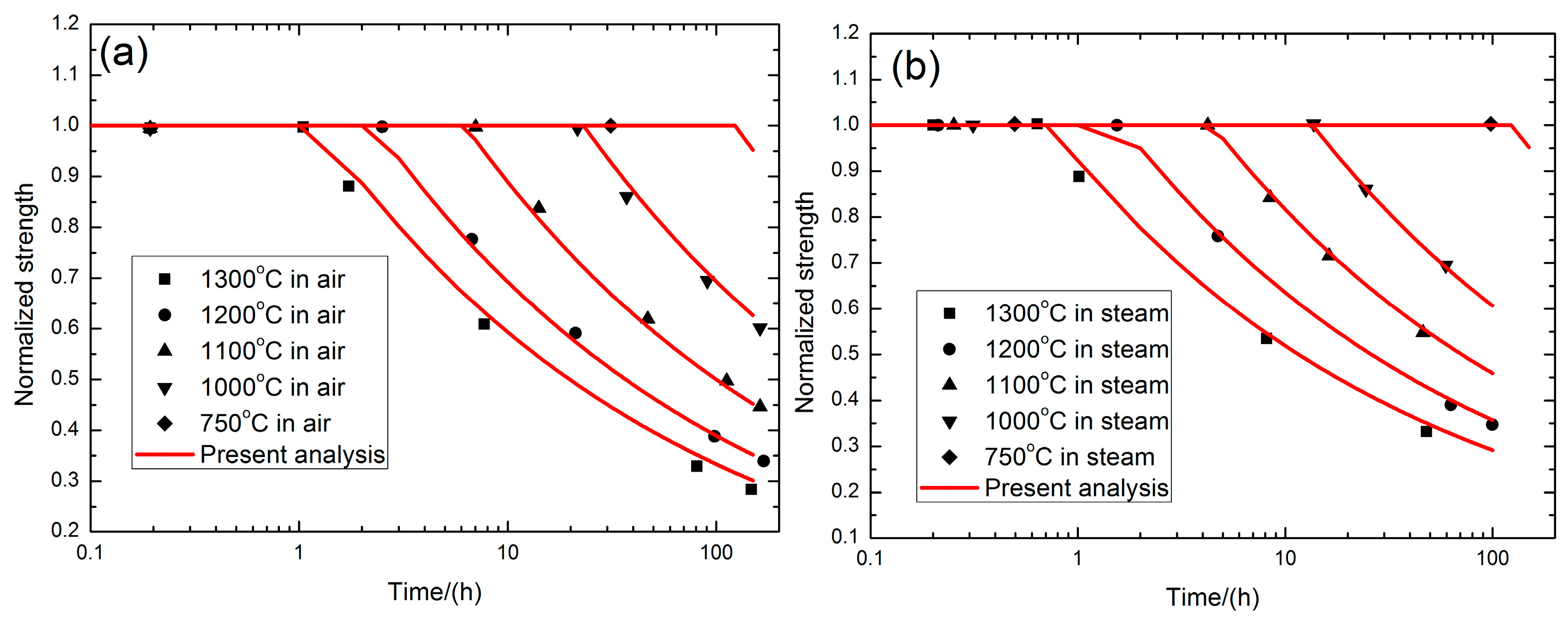
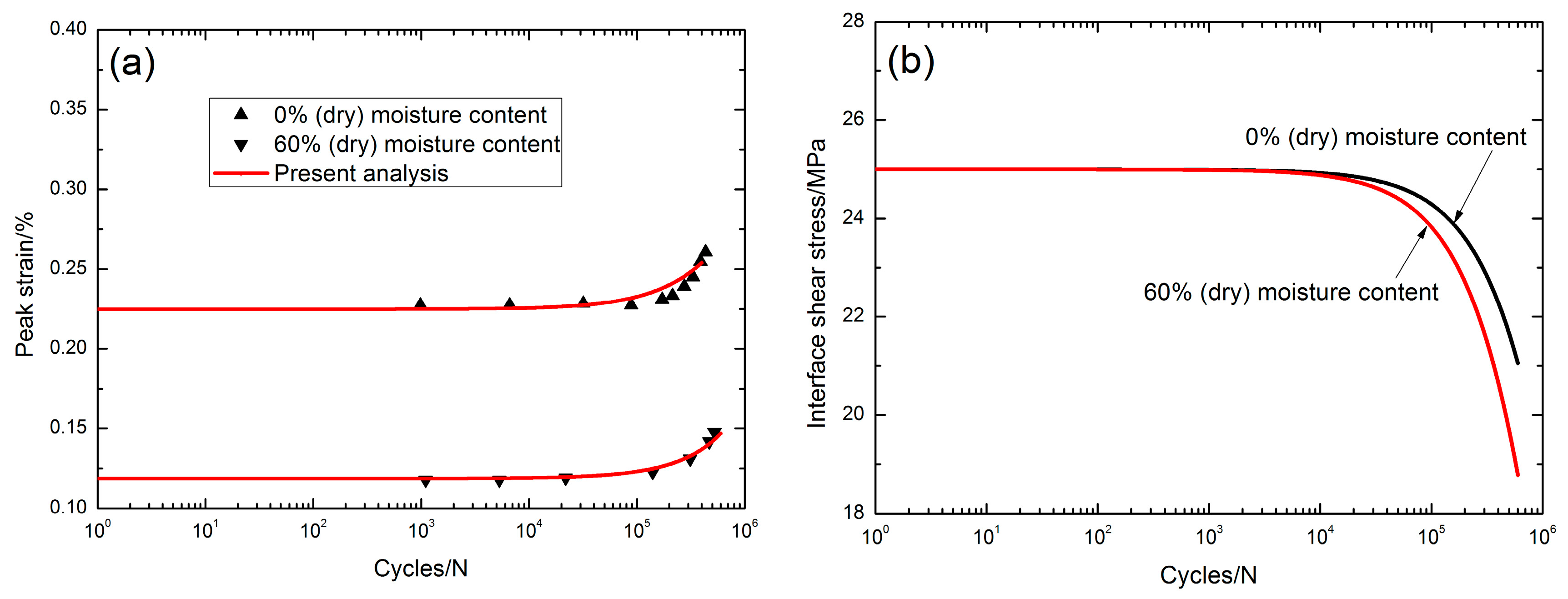
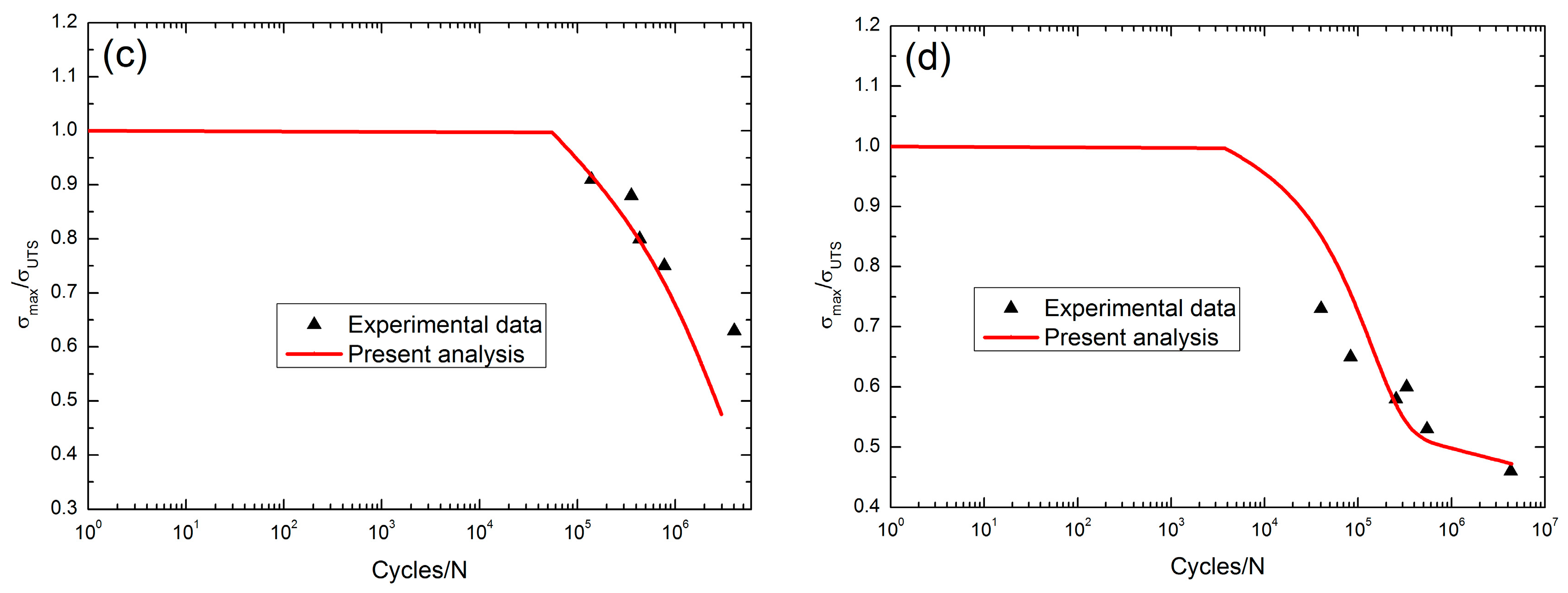




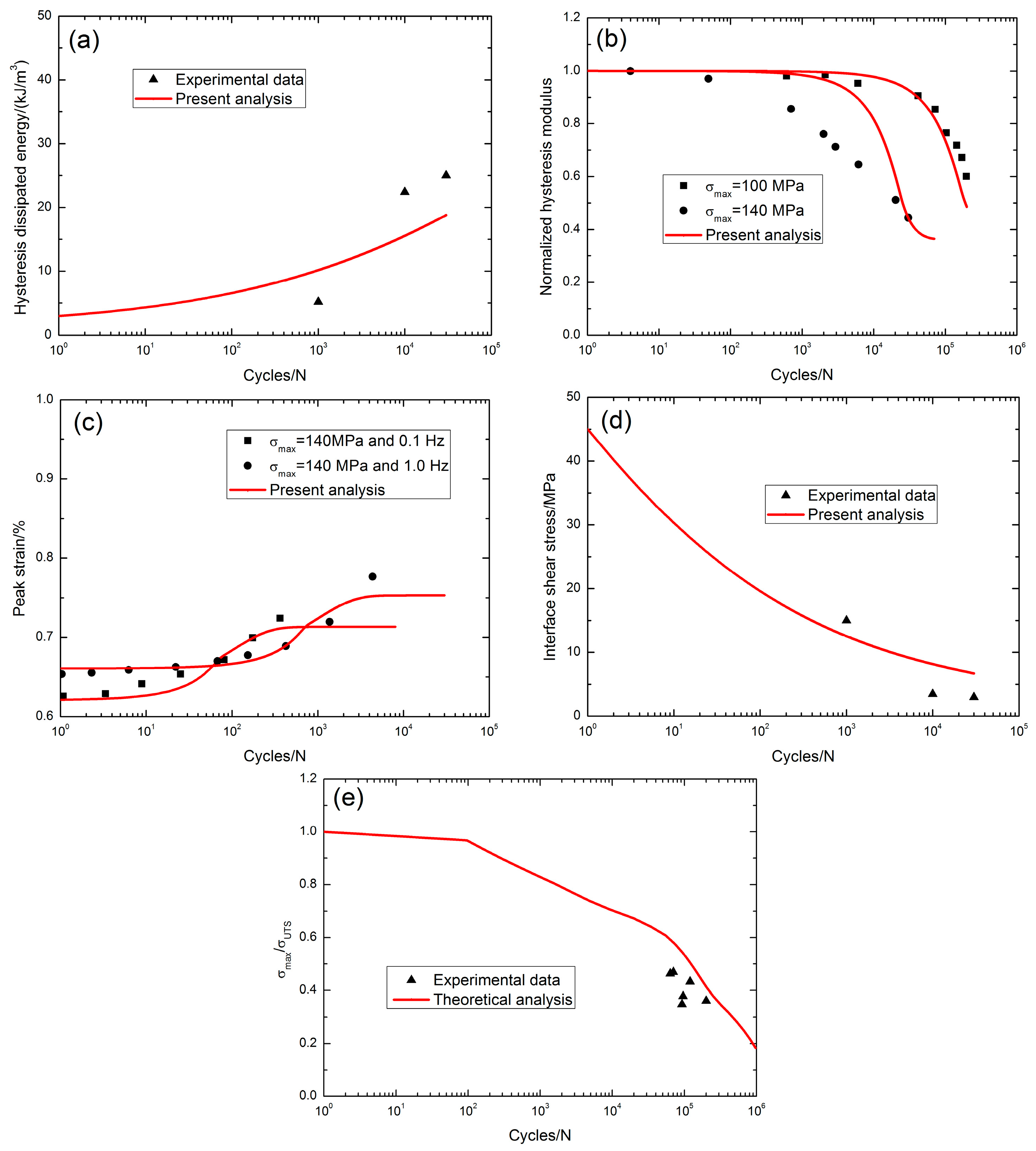
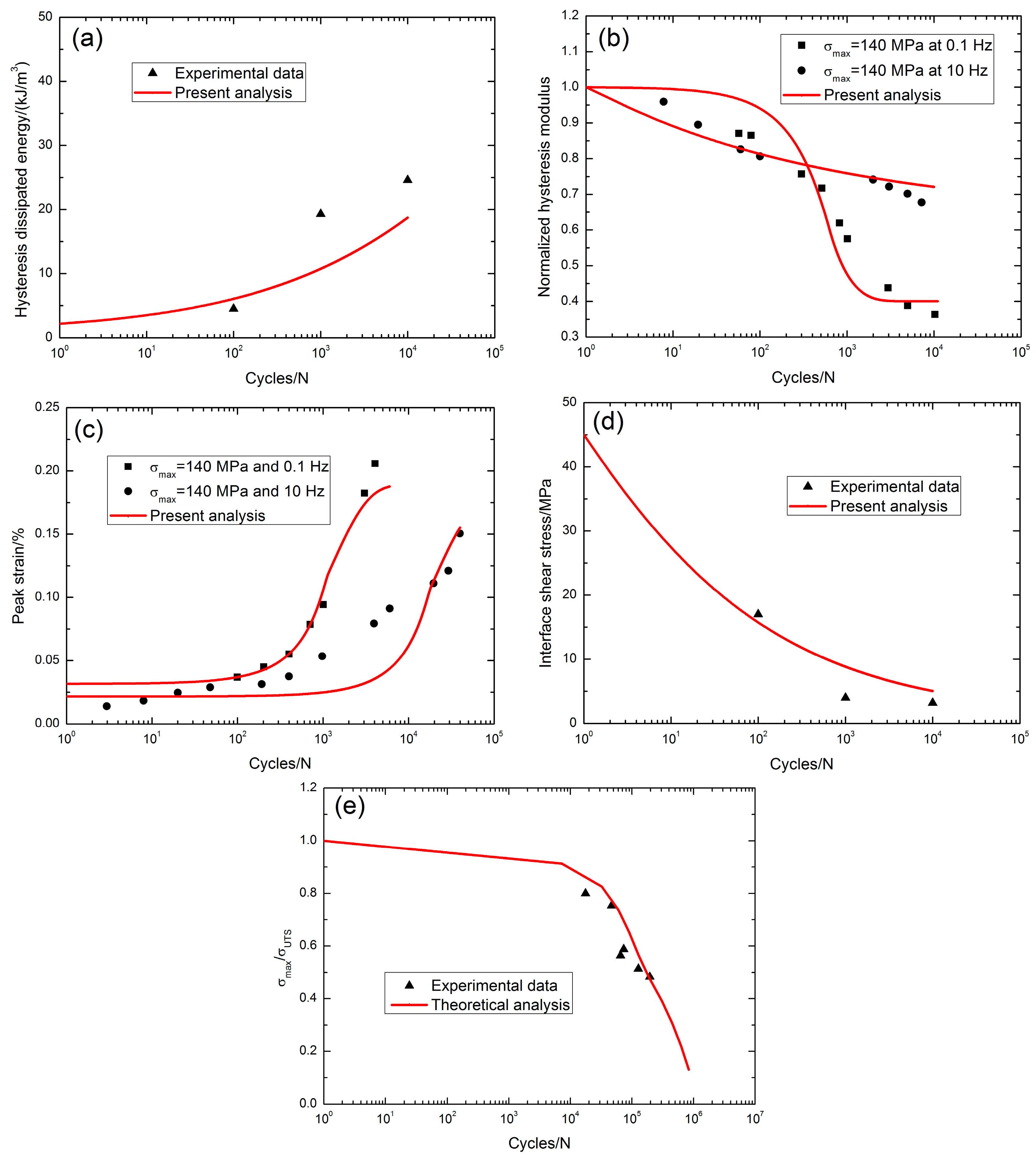
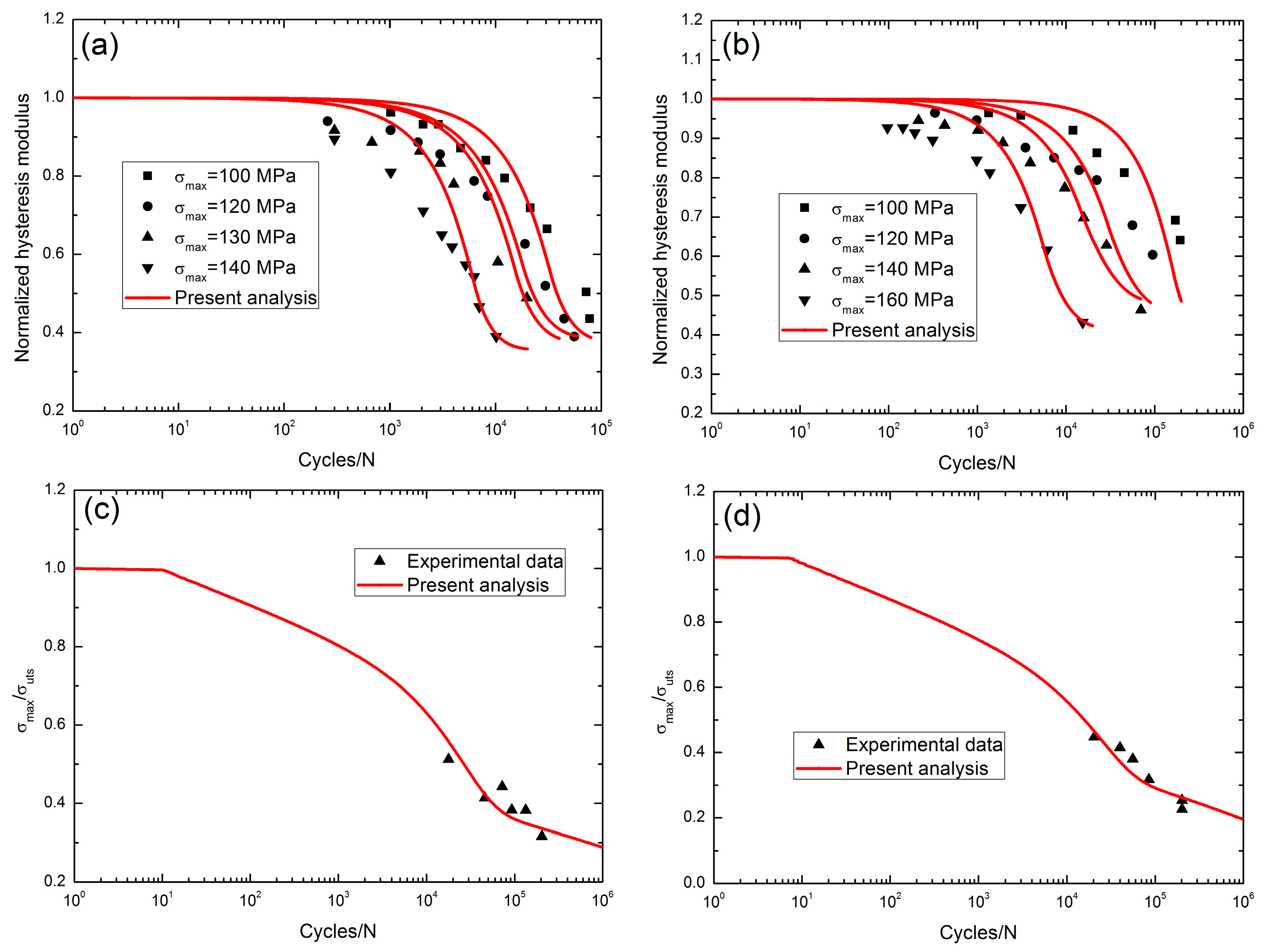
| Temperatures | Environment | σmax/MPa | τ0/MPa | τs/MPa | b0 | j |
|---|---|---|---|---|---|---|
| 750 °C | 0% moisture content | 284 | 25 | 1 | 1.0 | 5 × 10−7 |
| 60% moisture content | 190 | 25 | 1 | 1.0 | 3 × 10−7 | |
| 1000 °C | Air | 100 | 16 | 10 | 2.0 | 0.2 |
| Steam | 100 | 16 | 3 | 2.0 | 0.3 | |
| 1200 °C | Air | 140 | 45 | 2 | 2.0 | 0.2 |
| Steam | 140 | 45 | 1 | 2.0 | 0.3 |
© 2017 by the author. Licensee MDPI, Basel, Switzerland. This article is an open access article distributed under the terms and conditions of the Creative Commons Attribution (CC BY) license (http://creativecommons.org/licenses/by/4.0/).
Share and Cite
Li, L. Fatigue Damage and Lifetime of SiC/SiC Ceramic-Matrix Composite under Cyclic Loading at Elevated Temperatures. Materials 2017, 10, 371. https://doi.org/10.3390/ma10040371
Li L. Fatigue Damage and Lifetime of SiC/SiC Ceramic-Matrix Composite under Cyclic Loading at Elevated Temperatures. Materials. 2017; 10(4):371. https://doi.org/10.3390/ma10040371
Chicago/Turabian StyleLi, Longbiao. 2017. "Fatigue Damage and Lifetime of SiC/SiC Ceramic-Matrix Composite under Cyclic Loading at Elevated Temperatures" Materials 10, no. 4: 371. https://doi.org/10.3390/ma10040371






